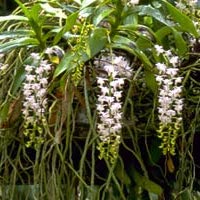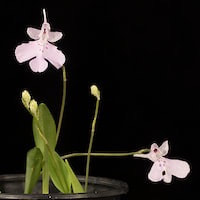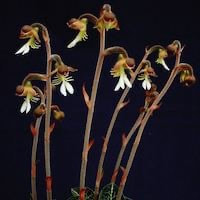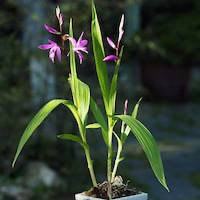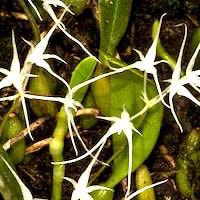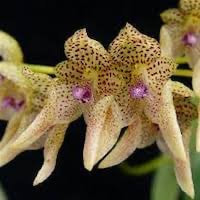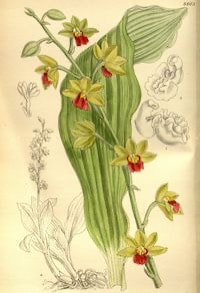Discover Oriental 5: The Ultimate Men's Fragrance
The Oriental 5 (Men) for Team building Perfume workshop offers an enchanting fragrance that combines scented notes from various orchids along with other aromatic elements:
- Native Singaporean Orchid notes: Aerides Odorata - This orchid is closely related to Vanda orchids and is known for its waxy, fragrant flowers with a unique pointed spur. Its distribution spans through the Himalayas, Singapore, Assam, Bangladesh, India, Nepal, Andaman Islands, Myanmar, and Southeast Asia. The flowers are fragrant and open widely, with purple to almost white colors, often tipped and spotted purple.
- Therapeutic Orchid notes:
- Amitostigma pinguicula (Chinese name: Dahuawuzhu Lan) - This medicinal orchid, found in Fujian, Zhejiang, Hubei, and Sichuan, is used for detoxification, reducing swelling, treating trauma and snake bites, acting as an antidote for poisons, and treating haematemesis.
- Anoectochilus koshunensis Hayata - Also known as Gaoxiong Jinxian Lan in Chinese and Kaohsiung (jewel orchid) in Taiwanese, this orchid has medicinal properties used to treat haemoptysis from tuberculosis, diabetes, bronchitis, nephritis, cystitis, convulsions, and snake bites. It contains kinsenoside and five sterols with potential health benefits.
- Bletilla striata - Known as Baiji in Chinese, this orchid is used in traditional Chinese medicine to treat swelling, haemorrhage, and promote tissue regeneration. It is also used for treating tuberculosis, gastric bleeds, skin disorders, and more. Scientists have identified antimicrobial agents and antihelminthic substances from this orchid.
- Bulbophyllum kwangtungense (Chinese name: Guangdongshidou Lan) - This miniature orchid, native to China, Hong Kong, and Lantau Islands, is used in traditional medicine to treat coughs, reduce heat, clear wind, and convulsions in children. It is also employed for rheumatism, arthritic pain, traumatic injuries, and mastitis.
- Bulbophyllum umbellatum (Syn. Cirrhopetalum maculosum) - This orchid found in the western Himalayas and Thailand contains cirrhopetalanthrin, a dimeric phenanthrene derivative, and is used in Ayurvedic preparations. The roots of this orchid are believed to promote longevity.
- Calanthe tricarinata Lindl. (Chinese name: Sanlengxiaji Lan, Chinese medicinal name: Jiuzilianhuancao) - Found in various regions of China, this orchid is used to stimulate blood circulation, relax muscles and joints, remove wind, and stop bleeding. It is employed to treat stomachache, arthritis, lumbar muscle degeneration, and traumatic injuries.
- Other scent notes: The fragrance is further enriched with scents of bergamot, lavender, geranium, violets, mitti attar (earthy fragrance), leather, and musk.
Other fragrance oils - Oriental 1, Oriental 2, Oriental 3, Oriental 4, Oriental 5, Oriental 6, Oriental 7, Oriental 8, Oriental 9, Oriental 10, Oriental 11, Oriental 12
Download the guided mediation that works best with this Orchid fragrance oil
| men_oriental_essential_oil_orchi_00005.mp3 | |
| File Size: | 105479 kb |
| File Type: | mp3 |
Experience Premium Oriental Floral Fragrance
Contains Scented Notes of following in various proportions:
Native Singaporean Orchid notes: Aerides Odorata
|
Aerides Odorata - Used in Oriental 5 (Men) for Team building Perfume workshop
Aerides odorata, commonly known as the Fragrant Aerides or Fragrant Orchid, is a species of orchid closely related to Vanda orchids. It shares similarities in growth habit and morphology with Vanda orchids but can be distinguished by its waxy, fragrant flowers with a differently pointed spur. The plant is widespread throughout various regions, including the Himalayas, Singapore, Assam, Bangladesh, India, Nepal, Andaman Islands, Myanmar, and other parts of Southeast Asia. The flowers of Aerides odorata are fragrant, opening widely, and measure 1.5-3 cm in diameter. They come in a range of colors, from purple to almost white, often with purple tips and spots. The spur apex is typically greenish-yellow. In various cultures, this orchid has different names and is appreciated for its fragrance and ornamental value. In Chinese, it is known as "Xianghuazhijia Lan" (fragrant-flowered Zhijia orchid), in Indonesian as "Angkrek Lilin" or "Lau Bintang," and in Thai as "Ueang Kulaab Krapao Pid." In India, particularly in the state of Orissa, it is referred to as "Hameri." Traditional uses of Aerides odorata are found in different countries. In India, fallen fruits of the plant are used to heal wounds. The juice extracted from the leaves is applied to treat boils in the ear and nose. In Vietnam, herbalists believe that sprinkling the seeds over lesions helps heal boils and other skin disorders. Moreover, the plant is used to treat tuberculosis, cuts, wounds, and is employed as an oral medicine for painful swollen joints. The presence of medicinal properties in Aerides odorata has made it a valuable resource in traditional medicine across various regions. However, scientific research is needed to validate and understand the potential pharmacological effects of this orchid. Studying the chemical constituents and active compounds present in Aerides odorata could lead to the discovery of new therapeutic agents or the identification of compounds with beneficial effects. As with any medicinal plant, it is essential to approach the use of Aerides odorata with caution and under the guidance of trained healthcare professionals. Traditional knowledge and practices can offer valuable insights into potential medicinal properties, but further scientific investigation is necessary to fully understand the effectiveness and safety of herbal treatments. In conclusion, Aerides odorata, also known as the Fragrant Aerides, is a beautiful and fragrant orchid species with potential medicinal properties. Its widespread distribution and traditional uses in various cultures highlight its importance in local medicine systems. Scientific research is crucial to validate its traditional uses and explore its potential applications in modern medicine. Additionally, efforts to conserve this orchid species and its natural habitats are essential to ensure its sustainability for future generations. |
Therapeutic Orchid notes:
|
Amitostigma pinguicula
Chinese names: Dahuawuzhu Lan (big flower no pillar orchid) Amitostigma pinguicula, commonly known as the Big Flower No Pillar Orchid, is a medicinal orchid used in traditional medicine in various forms. It is found in regions of China, including Fujian, Zhejiang, Hubei, and Sichuan. In traditional medicine, the entire plant of Amitostigma pinguicula is utilized to prepare various remedies. It is known for its detoxification properties and is used to reduce heavy swellings. Additionally, the plant is employed in the treatment of trauma and snake bites, making it valuable as an antidote for poisons. Moreover, Amitostigma pinguicula is used in the treatment of haematemesis, a condition characterized by the vomiting of blood. As a medicinal herb, Amitostigma pinguicula plays a significant role in traditional healthcare practices in the regions where it is found. However, it is essential to note that the traditional use of this plant may not have been thoroughly studied in scientific research. Therefore, its medicinal properties and safety should be further investigated through rigorous scientific studies and clinical trials. Traditional knowledge about medicinal plants like Amitostigma pinguicula offers valuable insights into their potential therapeutic benefits. However, it is essential to approach the use of traditional remedies with caution and under the guidance of qualified healthcare professionals. Integrating traditional practices with evidence-based medicine can lead to the discovery of new treatments or the identification of bioactive compounds with potential pharmaceutical applications. Efforts to conserve and protect Amitostigma pinguicula and its natural habitats are also crucial to ensure the sustainability of this valuable medicinal plant for future generations. Conservation initiatives can help maintain biodiversity and preserve the traditional knowledge associated with the use of this orchid in traditional medicine. In conclusion, Amitostigma pinguicula, or the Big Flower No Pillar Orchid, is a medicinal plant used in traditional medicine in various regions of China. Its traditional uses include detoxification, reducing swellings, treating trauma and snake bites, acting as an antidote for poisons, and addressing haematemesis. While traditional knowledge provides valuable insights, scientific research is necessary to validate its medicinal properties and ensure its safe and effective use in healthcare practices. Conservation efforts are also essential to protect this species and its traditional knowledge for the benefit of current and future generations. |
|
Anoectochilus koshunensis Hayata
Chinese name: Gaoxiong Jinxian Lan (Gaoxiong golden thread orchid) Taiwanese name: Kaohsiung (jewel orchid). Other common names: Hengchunjinxianlian (Hengchun golden thread lotus); Jinxian Lan (golden thread orchid). In Taiwanese (Hokien) dialect: Ko hiong kim soa lian; Heng chhun kim soa lian Anoectochilus koshunensis Hayata, also known as Gaoxiong Jinxian Lan (Gaoxiong golden thread orchid) in Chinese and Kaohsiung (jewel orchid) in Taiwanese, is a medicinal orchid with various traditional uses. It is found in Taiwan and is also known as Hengchunjinxianlian (Hengchun golden thread lotus) and Jinxian Lan (golden thread orchid) in some regions. In traditional Chinese medicine, the whole plant of Anoectochilus koshunensis is believed to "cool the blood and smoothe the liver." It possesses antipyretic properties and is considered to have detoxifying effects. This orchid is commonly used to treat several health conditions, including haemoptysis from tuberculosis, diabetes, bronchitis, nephritis, cystitis, convulsions, and snake bites. Scientific research on Anoectochilus koshunensis has led to the isolation of several bioactive compounds. Among these, kinsenoside has been identified, which may contribute to the plant's medicinal properties. Additionally, five sterols have been isolated from this orchid, including a new sterol with a non-conventional side chain, namely 26-methylstigmasta-5,22,25, (27)-trien-3 beta-ol. Another compound found in Anoectochilus koshunensis is a megastigmane glucoside, as well as 20-deoxyadenosine. The traditional use of Anoectochilus koshunensis in various health conditions suggests its significance in traditional healthcare practices. However, it is essential to conduct further scientific studies to validate the medicinal properties of this orchid and its bioactive compounds. Clinical trials and rigorous research are necessary to understand its potential therapeutic applications and safety profile. As with all traditional remedies, it is important to approach the use of Anoectochilus koshunensis under the guidance of qualified healthcare professionals. Integrating traditional medicine with evidence-based practices can lead to a better understanding of the medicinal properties of this orchid and its potential role in modern healthcare. Efforts to conserve Anoectochilus koshunensis and its natural habitats are also vital to protect this valuable medicinal plant. Conservation initiatives can help maintain biodiversity and preserve the traditional knowledge associated with the use of this orchid in traditional medicine, benefiting both cultural heritage and potential future medical applications. |
|
Bletilla striata
Chinese name: Baiji (white mucilaginous root, white chicken), Gangen (sweet root), Baigen (white root), Baijiertou (white hen’s head/ top), Shantianji (mountain frog) Lian Ji Cao. Bak-kup in Hong Kong, Taiwanese (Hokien) dialect: Peh kiu (white ginger) Japanese: Shiran (purple orchid, Japanese Urn Orchid) Korean name: Jaran Vietnamese names: Bach cap; Hua lan tia Bletilla striata, commonly known as Baiji (white mucilaginous root) or Purple Orchid, is a medicinal orchid found in China, Korea, Japan, and Vietnam. It is commercially cultivated in several provinces of China, including Guizhou, Yunnan, Jiangxi, and Guangxi. Bletilla striata has a bitter, sweet, and acerbic taste and is considered slightly cold in Traditional Chinese Medicine (TCM), benefiting the lungs, liver, and stomach meridians. In TCM, the tubers of Bletilla striata are cut into thin slices or crushed into a fine powder after cleaning and drying. When chewed, they become gluey, and the powder, when mixed with water, also turns gluey, requiring storage in air-tight containers. The medicinal uses of Bletilla striata include treating swelling, haemorrhage, and promoting the regeneration of muscles and tissues. It is administered to patients with tuberculosis who cough up blood due to bleeding in bronchiectasis. Additionally, it helps with gastric bleeds, bleeding from trauma or burns, bleeding pustules, bleeding ulcers, fissure-in-ano, and skin fissures caused by exposure to cold. The orchid is also used to treat sores, scaling, and chapped skin. In Vietnam, it is used as an emollient for burns. Bletilla striata contains bioactive compounds with medicinal properties. Among these are bibenzyls, such as 4,7-dihydroxy-1-p-hydroxybenzyl-2-methoxy-9,10-dihydrophenanthrene, 3,30-dihydroxy-2060-bis (p-hydroxybenzyl)-5-methoxybibenzyl, and 2,6-bis(p-hydroxybenzyl)-305-dimethoxy-3-hydroxybibenzyl. Dihydrophenanthrenes like 3,30-dihydroxy-5-methoxy-2,506-tris (p-hydroxybenzyl) bibenzyl and 4,7-dihydroxy-2-methoxy-9,10-dihydrophenanthrene are also present. Bletilla striata exhibits antimicrobial activity against Gram-positive bacteria and certain fungi. In research, scientists have isolated antihelminthic substances from Bletilla striata, which work against Clonorchiasis, a disease caused by liver flukes. The orchid has been utilized in developing a novel gene carrier from bioactive glucomannan, which may be used for anti-inflammatory therapy by inhibiting the expression of TNF-alpha. Bletilla striata polysaccharide (BSP) has shown promise as a gene carrier for delivering cytotoxic agents to tumours and as an embolization agent for treating unresectable liver tumours. Overall, Bletilla striata has a long history of use in traditional medicine, and modern research continues to unveil its potential therapeutic applications. As with any traditional remedy, it is essential to consult with qualified healthcare professionals for safe and appropriate use. Additionally, conservation efforts are crucial to protect Bletilla striata and its natural habitats for future generations and the continuation of traditional knowledge and potential medical applications. |
|
Bulbophyllum kwangtungense
Chinese name: Guangdongshidou Lan (Guangdong Province stone bean orchid) A miniature Bulbophyllum that flowers from May to August. It thrives on rocks in forests of China, Hong Kong and Lantau Islands. Bulbophyllum kwangtungense, also known as Guangdong Province stone bean orchid, is a miniature orchid species that blooms from May to August. It is typically found thriving on rocks in forests in regions of China, Hong Kong, and Lantau Islands. In traditional Chinese medicine, various parts of this orchid are used for medicinal purposes. The pseudobulbs of Bulbophyllum kwangtungense can be used either fresh or steamed and powdered. The taste is described as dry, bland, and cold in nature. According to traditional Chinese medicine principles, this orchid is believed to release heat, nourish yin (the cooling and moistening function of the body), and alleviate swelling. It has been traditionally used to treat coughs, reduce "heat" in the body, dispel "wind" (a concept related to disorders of the nervous system), and relieve convulsions in children. Additionally, it is used for conditions like rheumatism, arthritic pain, traumatic injuries, and mastitis. When used externally, pounded pseudobulbs are applied to the affected areas. It is important to note that traditional Chinese medicine often considers the individual's body constitution and temperature tendencies. Bulbophyllum kwangtungense is believed to be more suitable for individuals with a "cold body" constitution, and caution is advised for those with different body types. Chemical studies have revealed the presence of several bioactive compounds in Bulbophyllum kwangtungense. These compounds include cumulatin, densiflorol A, plicatol B, and three dihydrodibenzoxepins, namely 7,8-dihydro-5-hydroxy-12,13-methylenedioxy-11-methoxyldibenz[b,f]oxepin, 7,8-dihydro-3-hydroxy-12,13-methylenedioxy-11-methoxyldibenz[b,f]oxepin, and dibenz[b,f]oxepin. Among these compounds, the three dihydro-benzoxepins have demonstrated antitumor activities against HeLa and K562 human tumor cell lines. This indicates their potential in cancer research and treatment. Dibenz[b,f]oxepin, in particular, has been identified as a stress metabolite, suggesting its role in the plant's response to environmental stressors. While traditional use and chemical studies show promising aspects of Bulbophyllum kwangtungense, further research is needed to fully understand its pharmacological properties and potential medical applications. As with all herbal remedies, it is essential to consult with qualified healthcare professionals before using this orchid or any other herbal medicine for therapeutic purposes. Additionally, the conservation of Bulbophyllum kwangtungense and its natural habitats is crucial to preserve biodiversity and protect traditional medicinal resources. |
|
Bulbophyllum umbellatum
Bulbophyllum umbellatum, also known as Cirrhopetalum maculosum, is an orchid species distributed in the western Himalayas and Thailand. This orchid has attracted attention due to its chemical constituents and traditional medicinal uses. Chemical studies have revealed the presence of cirrhopetalanthrin, a dimeric phenanthrene derivative, in Bulbophyllum umbellatum. This compound is of interest to researchers due to its unique chemical structure and potential pharmacological properties. Further studies are needed to explore its potential therapeutic applications and mechanisms of action. In traditional medicine, particularly in Ayurveda, Bulbophyllum umbellatum is known by the name "swarna jivanti." The roots of this orchid are believed to possess medicinal properties that promote longevity and overall well-being. Ayurveda, the ancient system of medicine in India, uses a holistic approach to health and emphasizes the balance of mind, body, and spirit. Swarna jivanti is considered a rejuvenating herb in Ayurveda and is believed to have adaptogenic properties, helping the body cope with stress and promoting vitality. The use of swarna jivanti in Ayurvedic preparations may vary depending on the specific formulations and intended therapeutic effects. It is commonly used in herbal formulations aimed at enhancing vitality, improving overall health, and supporting the body's natural defense mechanisms. As with many traditional medicines, the use of Bulbophyllum umbellatum in Ayurvedic preparations is based on traditional knowledge and practices passed down through generations. However, it is important to note that scientific evidence supporting its specific medicinal properties and safety is limited and more research is needed to validate its traditional uses. In addition to its medicinal significance, conservation efforts are essential to protect Bulbophyllum umbellatum and its natural habitats. Overharvesting and habitat loss threaten many orchid species, including Bulbophyllum umbellatum. Sustainable harvesting practices and habitat preservation are crucial to ensure the long-term survival of this valuable plant species and its potential benefits to both traditional medicine and scientific research. |
|
Calanthe tricarinata Lindl.
Chinese name: Sanlengxiaji Lan (triangular prism prawn spine orchid) Chinese medicinal name: Jiuzilianhuancao (nine united sons flowering herb) This name also refers to Calanthe discolor; Roulianhuan Calanthe tricarinata, also known as the triangular prism prawn spine orchid, is a species of orchid found in various regions of China, including Shanxi, Hubei, Sichuan, Yunnan, Guangxi, Guizhou, and Xizang (Tibet). It is also found in neighboring countries like Nepal and Uttarakhand in the West Himalayas. In traditional medicine practices, Calanthe tricarinata has been utilized for its various medicinal properties. In Nepal, the leaf paste of this orchid is used to treat wounds and eczema. Additionally, in Nepal, both the leaves and pseudobulbs of Calanthe tricarinata are valued as aphrodisiacs. In Uttarakhand, West Himalaya, the roots and leaves of this orchid are used to treat jaundice and typhoid. These traditional uses are based on the local knowledge and practices passed down through generations. In China, Calanthe tricarinata has been used as a medicinal herb. The root of the orchid is considered to have therapeutic effects on blood circulation and is used to relax muscles and joints. It is also believed to have properties to remove wind and stop bleeding. As a result, it is used to treat various conditions, including stomachache, arthritis, lumbar muscle degeneration, and traumatic injuries. It is important to note that while Calanthe tricarinata has been traditionally used for various medicinal purposes, scientific evidence supporting its efficacy and safety in these applications is limited. More research is needed to validate and better understand its potential medicinal properties. As with all medicinal plants, conservation efforts are crucial to protect Calanthe tricarinata and its natural habitats. Overharvesting and habitat destruction pose significant threats to many orchid species, including Calanthe tricarinata. Sustainable harvesting practices and habitat preservation are essential to ensure the continued existence of this valuable plant species and its potential contributions to traditional medicine and scientific research. |
Other scent note
Scentopia Library Reference ingredient
Tanjong Tree - Sentosa's plants - Check details at Scentopia's scent library
Join Scentopia's wonderful orchid scent crafting, fragrance tour, bridal shower or corporate team building which includes perfume making onsite and offsite, beach activities and more. We also serve primary school learning journey, secondary students and pupil on industrial excursions. Know more about our orchids perfume bar or therapeutic orchid scents and other wellness aromas. Conatct Perfume workshop or book a scent crafting session here.
